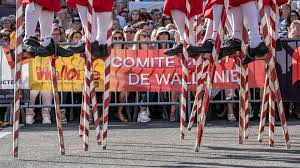Folkloric Combat
Video games have long drawn inspiration from mythology and folklore, weaving ancient tales into interactive experiences that captivate players. Among these, Folkloric Combat games stand out as a unique subgenre, blending the mystique of cultural legends with dynamic, action-packed gameplay. These games immerse players in worlds where mythical creatures, legendary heroes, and supernatural forces collide, offering a rich narrative and strategic combat systems. This article delves into the essence of Folkloric Combat games, exploring their origins, mechanics, cultural significance, and enduring appeal.

The Roots of Folkloric Combat
The concept of Folkloric Combat in gaming draws heavily from global mythologies, where stories of gods, spirits, and legendary battles have been passed down through generations. Games like Folklore (2007) for the PlayStation 3, developed by Game Republic, exemplify this subgenre by setting their narratives in worlds inspired by Irish mythology, such as the Celtic Otherworld. In Folklore, players control characters like Ellen and Keats, navigating the quaint village of Doolin and the fantastical Netherworld to battle folk creatures and unravel mysteries. This fusion of real-world settings with mythical realms creates a compelling backdrop for combat, grounding fantastical elements in relatable cultural contexts.
The origins of Folkloric Combat games can be traced to early role-playing games (RPGs) and action-adventure titles that incorporated mythological themes. Titles like The Legend of Zelda series introduced players to creatures inspired by European folklore, while God of War reimagined Greek and Norse myths through visceral combat. These games laid the groundwork for a subgenre where folklore is not just a backdrop but a core mechanic, influencing everything from enemy design to player abilities.
Mechanics of Folkloric Combat
At the heart of Folkloric Combat games lies their unique gameplay mechanics, which often revolve around capturing, summoning, or harnessing the powers of mythical creatures. In Folklore, players collect “Ids,” the essences of defeated folk creatures, which can be used to execute special attacks or abilities. This mechanic mirrors the monster-collection systems seen in games like Pokémon but is steeped in mythological flavor, with creatures drawn from Irish tales like banshees and faeries. The combat system emphasizes strategy, requiring players to choose the right folk for specific battles, balancing offensive and defensive capabilities.
Folkloric Combat games often employ third-person perspectives, allowing players to fully engage with the vibrant, otherworldly environments. Area-of-effect (AoE) abilities, where spells or attacks impact a specific radius, are common, adding a layer of tactical depth. For instance, a player might use a banshee’s wail to damage multiple enemies at once, requiring careful positioning to maximize effectiveness. Additionally, these games often feature dual-world mechanics, where players switch between a mundane world and a mythical one, each with distinct rules for exploration and combat. This duality enhances the narrative and keeps gameplay varied.
Cultural Significance and Storytelling
The appeal of Folkloric Combat games lies not only in their mechanics but also in their ability to preserve and reinterpret cultural narratives. By drawing on folklore from diverse regions—Celtic, Norse, Japanese, or otherwise—these games introduce players to stories and creatures they might not encounter otherwise. Folklore’s setting in Doolin, Ireland, for example, integrates local legends into its narrative, creating an authentic atmosphere that resonates with players. The game’s art direction, described as “stellar” by critics, enhances this cultural immersion, blending realistic village aesthetics with colorful, surreal Netherworld designs.
Storytelling in Folkloric Combat games often revolves around quests that explore themes of memory, identity, and the supernatural. In Folklore, the protagonists’ intertwined storylines delve into personal and collective histories, with quests that progress through interactions with both the living and the dead. This narrative depth, combined with combat, makes these games stand out in the RPG and action-adventure genres. The emphasis on folklore also allows developers to explore universal themes like good versus evil or human versus nature, making the stories accessible yet culturally specific.
Enduring Appeal and Modern Examples
The enduring appeal of Folkloric Combat games lies in their ability to blend nostalgia with innovation. Players are drawn to the familiarity of mythological tales, yet the interactive nature of gaming allows for fresh interpretations. Modern examples, such as Hades (2020), continue this tradition by reimagining Greek mythology through fast-paced combat and roguelike mechanics. Hades features gods and creatures like Cerberus and the Furies, with abilities that reflect their mythological roles, such as Athena’s protective shields or Poseidon’s tidal attacks. The game’s success highlights the continued relevance of folklore in gaming.
Another modern example is Kādomon: Hyper Auto Battlers (2024), which incorporates Japanese folklore-inspired creatures in a strategic auto-battler format. These games demonstrate how Folkloric Combat evolves, adapting traditional narratives to new genres while maintaining the core appeal of mythical battles. The use of bold, vibrant visuals and atmospheric soundtracks, as seen in Folklore’s critically praised design, further enhances player immersion.
Challenges and Future Directions
Despite their appeal, Folkloric Combat games face challenges in balancing accessibility with authenticity. Overly complex combat systems or dense narratives can alienate casual players, while oversimplification risks diluting cultural elements. Developers must also navigate the fine line between homage and appropriation, ensuring that folklore is represented respectfully. Future titles could explore underrepresented mythologies, such as African or Indigenous American folklore, to broaden the subgenre’s scope.
The integration of Folkloric Combat into emerging technologies, like virtual reality, offers exciting possibilities. Imagine battling a Celtic sidhe in a fully immersive Netherworld or commanding Norse draugr in augmented reality. As gaming technology advances, Folkloric Combat games have the potential to deepen player engagement, making ancient stories more vivid and interactive.

Conclusion
Folkloric Combat games offer a unique blend of mythology, strategy, and storytelling, captivating players with their rich worlds and dynamic gameplay. From the Celtic-inspired Folklore to modern hits like Hades, these games demonstrate the timeless allure of folklore in interactive media. By combining cultural authenticity with innovative mechanics, Folkloric Combat games not only entertain but also preserve and reinterpret humanity’s oldest stories. As the genre continues to evolve, it promises to enchant players with new tales of heroism and myth, proving that the ancient art of storytelling remains as powerful in pixels as it was around ancient campfires.